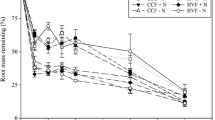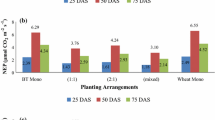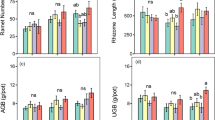Abstract
An experiment was conducted in an 11-year-old black walnut (Juglans nigra L.), red oak (Quercus rubra L.), maize (Zea mays L.) alley cropping system in the midwestern USA to examine the extent of tree-crop competition for nitrogen and decomposition dynamics of tree leaves and fine roots. A below-ground polyethylene root barrier (1.2 m deep) isolated black walnut roots from maize alleys in half the number of plots providing two treatments viz. ‘barrier’ and ‘no barrier’. The percentage of N derived from fertilizer (%NDF) and fertilizer use efficiency (%UFN) were determined using 15N enriched fertilizer. Further, maize grain and stover biomass, tree leaf biomass, tissue N concentration, and N content were quantified in both treatments. The ‘barrier’ treatment resulted in a significantly greater grain (67.3% more) and stover (37.2% more) biomass than the ‘no barrier’ treatment. The %NDF in both grain and stover was higher in the ‘no barrier’ treatment as a result of competition from tree roots for water and mineralized N in soil. Maize plants growing in the ‘no barrier’ treatment had a lower %UFN than those in the ‘barrier’ treatment due to their smaller size and inability to take up fertilizer. Analysis of tree leaf and fine root decomposition patterns revealed faster release of N (39% over 15 days for black walnut and 17.7% for red oak) and P (30% over 15 days for both species) from roots compared to the leaves of both species. Following an early release of P (11.3% over 45 days), red oak leaves exhibited significant immobilization for the rest of the incubation period. The data indicate that competition for N from fertilizer is minimal since nutrient acquisition is not simultaneous among black walnut and maize. However, competition for mineralized N in soil can exist between black walnut and maize depending on water availability and competition. Tree leaves and fine roots can enhance soil nutrient pools through the addition of soil carbon and nutrients. Tree fine roots seem to play a more significant role in nutrient cycling within the alley cropping system because of their faster release of both N and P as compared to leaves. Selection of tree species and their phenology will impact the magnitude and rate of nutrient cycling.
Similar content being viewed by others
References
Adams MB and Angradi TR (1996) Decomposition and nutrient dynamics of hardwood leaf litter in the Fernow Whole-Watershed Acidification Experiment. For Ecol Manage 83: 61–69
Adler PR and Wilcox GE (1985) Rapid perchloric acid digest methods for analysis of major elements in plant tissue. Commun Soil Sci Plant Anal 16: 1153–1163
Barber LD, Joern BC, Volenec JJ and Cunningham SM (1996) Supplemental nitrogen effects on alfalfa regrowth and nitrogen mobilization from roots. Crop Sci 36: 1217–1223
Berg B and McClaugherty C (1989) Nitrogen and phosphorus release from decomposing litter in relation to the disappearance of lignin. Can J Bot 67: 1148–1156
Blair JM (1988) Nitrogen, sulfur and phosphorus dynamics in decomposing deciduous leaf litter in the southern Appalachians. Soil Biol Biochem 20: 693–701
Chirko CP, Gold MA, Nguyen PV and Jiang JP (1996) Influence of direction and distance from trees on wheat yield and photosynthetic photon flux density (Qp) in a Paulownia and wheat intercropping system. For Ecol Manage 83: 171–180
Fahey TJ, Hughes JW, Pu M and Arthur MA (1988) Root decomposition and nutrient flux following whole tree harvest of northern hardwood forest. For Sci 34: 744–768
Drossopoulos B, Kouchaji GG and Bouranis DL (1996) Seasonal dynamics of mineral nutrients and carbohydrates by walnut tree leaves. J Plant Nutr 19: 493–516
Garrett HE and Buck LE (1997) Agroforestry practice and policy in the United States of America. For Ecol Manage 91: 5–15
Garrett HE and Kurtz WB (1983) Silvicultural and economic relationships of integrated forestryfarming with black walnut. Agrofor Sys 1: 245–256
Garrett HE, Jones JE, Kurtz WB and Slusher JP (1991) Black walnut (Juglans nigra L) agroforestry – its design and potential as a land use alternative. For Chron 67: 213–218
Gillespie AR, Jose S, Mengel DB, Hoover WL, Pope PE, Seifert JR, Biehle DJ, Stall T and Benjamin TJ (2000) Defining competition vectors in a temperate alley cropping system in the midwestern USA: 1. Production physiology. Agrofor Syst 48: 25–40
Jose S, Gillespie AR and Seifert JR (2000) Defining competition vectors in a temperate alley cropping system in the midwestern USA. 2. Competition for water. Agrofor Syst 48: 41–59
Kang BT (1993) Alleycropping: past achievements and future directions. Agrofor Syst 23: 141–155
Kurtz WB, Garrett HE, and Kincaid WH (1984) Investment alternatives in black walnut plantation management.J For 82: 604–608
Lehmann J, Schroth G and Zech W (1995) Decomposition and nutrient release from leaves, twigs, and roots of three alley-cropped tree legumes in central Togo. Agrofor Syst 29: 21–36
McClaugherty CA, Aber JD and Melillo JM (1982) The role of fine roots in the organic matter and nitrogen budgets of two forested ecosystems. Ecology 63: 1481–1490
McClaugherty CA, Aber JD and Melillo JM (1984) Decomposition dynamics of fine roots in forested ecosystems. Oikos 42: 378–386
McClaugherty CA, Pastor J, Aber JD and Melillo JM (1985) Forest litter decomposition in relation to soil nitrogen dynamics and litter quality. Ecology 66: 266–275
Melillo JM, Aber JD, Linkins AE, Ricca A, Fry B and Nadelhoffer 6KJ (1989) Carbon and nitrogen dynamics along the decay continuum: plant litter to soil organic matter. Plant Soil 115: 189–198
Muchow RC and Sinclair TR (1995) Effect of nitrogen supply on maize yield: II. Field and model analysis. Agron J 87: 642–648
Olsen SR and Sommers LE (1982) Phosphorus. In: Page A, Miller A and Keeney D (eds) Methods of Soil Analysis Part 2, Chemical and Microbiological Properties, pp 403–430. Am Soc Agron, Madison, WI, USA
Ong CK, Corlett JE, Singh RP, and Black CR (1991) Above and below ground interactions in agroforestry systems. For Ecol Manage 45: 45–57
Palm CA (1995) Contribution of agroforestry trees to nutrient requirements of intercropped plants. Agrofor Syst 30: 105–124
Palm CA and Sanchez PA (1991) Nitrogen release from the leaves of some tropical legumes as affected by their lignin and polyphenolic contents. Soil Biol Biochem 23: 83–88
Schroth G, Zech W and Heimann G (1992) Mulch decomposition under agroforestry conditions in a sub-humid tropical savanna: processes and influence of perennial plants. Plant Soil 147: 1–12
Singh RP, Ong CK and Saharan N (1989) Above and below ground interactions in alleycropping in semiarid India. Agrofor Syst 9: 259–274
Sisworo WH, Mitrosuhardjo MM, Rasjiid H and Myers RJK (1990) The relative roles of N fixation, fertilizer, crop residues and soil in supplying N in multiple cropping systems in a humid, tropical upland cropping system. Plant Soil 121: 73–82
Thevathasan NV and Gordon AM (1997) Poplar leaf biomass distribution and nitrogen dynamics in a poplar-barley intercropped system in southern Ontario, Canada. Agrofor Syst 37: 79–90
Wienhold BJ, Trooien TP and Reichman GA (1995) Yield and nitrogen use efficiency of irrigated corn in the northern Great Plains. Agron J 87: 842–846
Author information
Authors and Affiliations
Corresponding author
Rights and permissions
About this article
Cite this article
Jose, S., Gillespie, A.R., Seifert, J.R. et al. Defining competition vectors in a temperate alley cropping system in the midwestern USA: 3. Competition for nitrogen and litter decomposition dynamics . Agroforestry Systems 48, 61–77 (2000). https://doi.org/10.1023/A:1006241406462
Issue Date:
DOI: https://doi.org/10.1023/A:1006241406462




